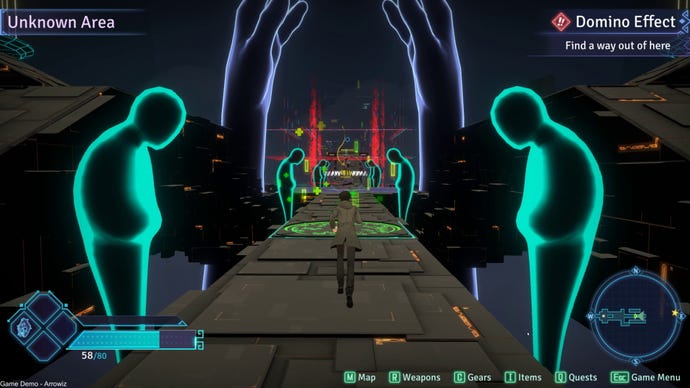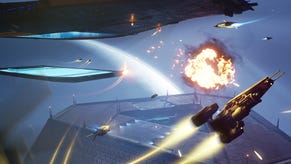This Chinese detective RPG wants to be part Persona, part visual novel
Mato Anomalies blends graphic novel-style adventuring with gumshoe dungeon-crawling
You're probably sick to the back teeth of games that describe themselves as having neo-futuristic cities by now, but hear me out. Mato Anomalies, an upcoming detective RPG from Chinese studio Arrowiz, doesn't really feel like just another cyberpunk game. Yes, there is an enormous Blade Runner-style hologram lady who emerged from round a street corner at one point during my hands on demo, and yes, some of its citizens are decked out in Razer-esque face masks. For the most part, though, the titular city of Mato feels more like an alternate version of turn of the century Shanghai than anything else, ditching glowing neon LEDs for a roaring 20s-style glitz and glamour.
You can see it in information broker Donna Nightshade, who's done up to the nines in diamond earrings and pearl tiaras as she prepares to open her nightclub for the evening. Before she can do that, though, she needs to deal with you, the player. You'll be stepping into the shoes of rookie PI Doe for most of Mato Anomalies, and Nightshade has strong-armed you into investigating some shady goings on down in Immortal Harbour. What follows is a stylish Persona-like adventure that's still quite rough around the edges at time of writing, but with a bit of spit shine boot polish could be one to watch when it launches next year.
Okay, maybe a lot of spit and polish. In my particular demo build, for example, the city of Mato was quite barren as I walked Doe between various objectives, its streets populated by only a handful of identikit civilians who often popped into frame at quite short distances. Many had blank, featureless faces - by design, I feel, as they looked quite stylised compared to other, more detailed NPCs I saw out and about - but even the ones that did have discernible features weren't always interactive. Many stood stock still with no way to talk to them, and if they did have something to say, they often only had a line or two they'd parrot ad infinitum. I was pleased to see a couple of cats dotted about here and there, but when I approached, they began to wig out so violently that they up and vanished right before my very eyes. So much for "can you pet the cat?", then.
Still, while its 3D exploration sections could probably be summarised as 'quaint PS2-era' at the moment, its 2D text conversations are an altogether different proposition. Here, character portraits shift, blink and breathe in real-time, breathing welcome life into what could have been static bits of character art. The backdrops behind them are frequently gorgeous as well, filling the screens with stylish soft watercolour paintings of its 3D landmarks. Occasionally, cutscenes will play out as living comic book panels, too, with characters briefly moving and settling into frame before the next scene appears in another portion of the screen. Yes, the animations are a little abrupt in their current state - I often felt like they could have been a couple of seconds longer, just to really luxuriate in the format - but it all adds to its pulpy, penny dreadful kind of vibe.

After taking the metro to Immortal Harbour, it's not long before Doe finds what he's looking for – almost as soon as he arrives, he overhears some nefarious-looking blokes complaining about how all their boxes just seem to disappear as soon as they place them inside a mysteriously dark shipping container. The writing is not subtle by any stretch of the imagination, but at least it doesn't waffle on. Within seconds, Doe is nosing around this container for himself, and gets immediately pulled into a strange abstract fantasy realm - the anomaly that gives the game its name. The whole thing looks extremely Persona, from the big glowing hands holding up long rectangular platforms right down to its horrible flesh monsters with insect legs and screaming statues poking out of their heads. You know, the classics.
Alas, Doe's regular human gun might as well be a water pistol in this weird dimension, but just before he too gets assimilated into the screeching stone insect carcass heading his way, a robed warrior descends from the sky to save his hide. His name is Gram, and he has a mean arm tattoo and a big magical sword. It's not entirely clear who or what Gram is in Mato Anomalies, but he's effectively the game's deuteragonist, and who you'll be controlling when you eventually travel back into other anomalies further down the line.


Mato Anomalies' battles are turn-based affairs and, much like Persona and other JPRGs of this ilk, take place in dedicated combat arenas where your main goal is biffing every last monster onscreen using a limited pool of attack commands. Foes are visible in the wider environment, too, and you're given the option to enter or leave the fight before engaging. In this particular anomaly, there wasn't much point in 'leaving', to be honest, as the linear design of the platforms meant fights were all but mandatory if you wanted to progress. It's the kind of thing I can see getting very grating if all anomalies are going to be structured like this, but it could be useful, say, if you accidentally encounter something horrible high-level and are totally ill-equipped to deal with it. Better a hasty retreat than a swift arse-kicking in those situations, although that's assuming there's a) a way round it, or b) there are other monsters to grind up your levels. In this demo, though, it was all pretty plain-sailing.
The battle spaces themselves were a bit drab, admittedly, with lots of grey mist hiding a rather plain grid pattern on the floor, but Gram's fast and fluid battle animations looked absolutely stunning, suggesting Arrowiz does have a similar eye for Atlus-level flair, even if the game's interior decorating is a little lacking right now. As this was very much a tutorial area, Gram gradually obtained more attacks with each passing battle, letting me sample a mix of simple sword slashes and multi-target attacks. More powerful abilities are limited by cooldown timers, and from the looks of things, you'll have to hit enemies with different types of attacks to learn their weaknesses - again, it's all very Persona.

Before any real boss battle shows up, though, the demo build spits us out of the anomaly and back into the real world again, setting up the game's general cadence of investigation sections followed by a bit of dungeon crawling. As I mentioned above, it's Gram who leads these latter sections, and you'll eventually gather more party members to fight alongside him. Doe, on the other hand, has no fighting capability, and will stick to doing his PI work to find out what's really going on with these strange pocket dimensions.
That's not to say Doe's completely powerless, though. In an unexpected twist, my demo closes with a kind of virtual reality card battle that lets Doe hack into the minds of potential suspects. It's a bit like the first-person RPG battling of ye olde Dragon Quests, as you can only play a handful of action points each turn. Cards are split into offensive and defensive cards, and the aim is to reduce your opponent's 'mind power' to zero, while also fending off extra monsters he throws at you periodically as well. These battles weren't quite as satisfying as Gram's sword fighting, admittedly. Not only were the rules a little hazy, but its UI was also a touch disorientating. Still, it's early days yet, and there's plenty of time for kinks like that to get ironed out. If nothing else, it's good to see Doe's sections will still have a chunky battling element to them despite not being party to the game's dungeon crawling segments.
Even so, Mato Anomalies is going to need to scrub up a lot more than just its card battles if it's going to truly stand out against its Atlus inspirations, especially now that Persona 5 Royal's imminent PC release will put it on the back foot. Persona 5 has such a slick level of polish to it that anything less just feels like a creaking imitation at this point, and Mato Anomalies has a heck of a long way to go before its glitz and glamour reaches the same kind of heights. Still, there are glimmers of something interesting here, and I hope Arrowiz are able to put in the elbow grease to really make it shine ahead of its launch next year.










